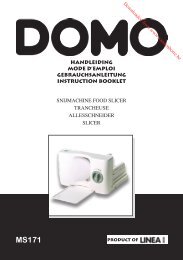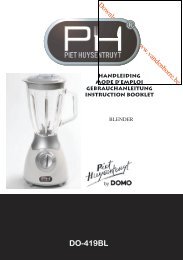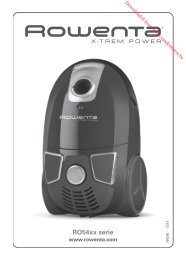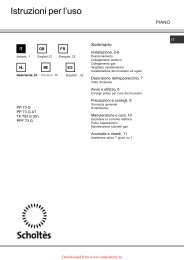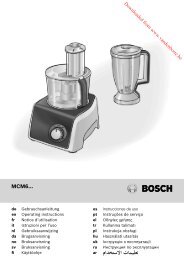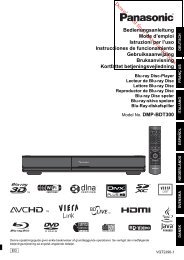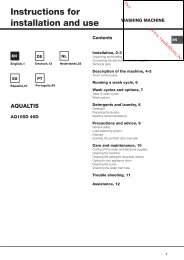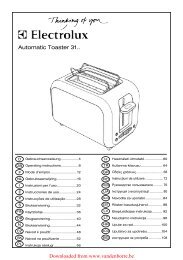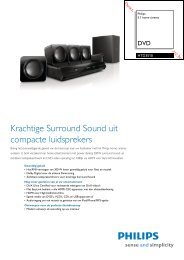Downloaded from www.vandenborre.be
Downloaded from www.vandenborre.be
Downloaded from www.vandenborre.be
Create successful ePaper yourself
Turn your PDF publications into a flip-book with our unique Google optimized e-Paper software.
<strong>Downloaded</strong> <strong>from</strong> <strong>www</strong>.<strong>vandenborre</strong>.<strong>be</strong><br />
<strong>www</strong>.domo-elektro.<strong>be</strong> B3990<br />
Sugar<br />
Sugar is very important for the crust colour and taste of the bread. It is also used as<br />
nutrient in yeast bread. White sugar is mainly used. Sometimes brown sugar, castor<br />
sugar or demerara sugar can <strong>be</strong> used too.<br />
Yeast<br />
Carbon dioxide is released during the fermentation process and it makes the bread<br />
lighter and the fibres softer. In order for the yeast to <strong>be</strong> able to multiply rapidly, carbon<br />
<strong>from</strong> sugar and flour are needed. In general, there are three types of yeast: fresh yeast,<br />
active dry yeast and instant yeast. Instant gist is used more often and works faster than<br />
active dry yeast but active dry yeast produces a <strong>be</strong>tter fermentation process.<br />
The conversion of the amount of active dry yeast to the amount of instant yeast takes<br />
place as follows:<br />
1 teaspoon active dry yeast = ¾ teaspoon instant yeast<br />
1.5 teaspoons active dry yeast = 1 teaspoon instant yeast<br />
2 teaspoons active dry yeast = 1.5 teaspoons instant yeast<br />
Yeast should <strong>be</strong> refrigerated <strong>be</strong>cause its active ingredients are destroyed at high<br />
temperatures. Each time you wish to use the yeast check the expiration date to make<br />
sure that it is still fresh. Put the yeast back into the refrigerator as soon as possible<br />
after each use. When bread fails to rise the most common fault is that the yeast has<br />
<strong>be</strong>come inactive/damaged.<br />
Use the following method to check whether or not the yeast is still active (live) and<br />
fresh:<br />
Pour a half cup of warm water (45-50°C) into a measuring cup.<br />
Add 1 teaspoon of white sugar and stir. Then sprinkle 2 teaspoons of yeast into the<br />
water.<br />
Place the measuring cup in a warm spot for about 10 minutes. Do no stir the mixture.<br />
The foam should fill almost the entire cup. If it fails to do so then it means that the<br />
yeast is poor or no longer active.<br />
Salt<br />
Salt is necessary to improve the taste of the bread and to give the crust colour.<br />
However, salt can also lead to the yeast failing to rise. So <strong>be</strong> careful not to use<br />
excessive salt in a recipe. If you do not wish to use salt you can omit this ingredient,<br />
this will result in slightly larger loaves.<br />
Eggs<br />
Eggs improve the structure of the bread and give it more nutritional value.<br />
Fat, butter and vegetable oil<br />
Fat makes the bread softer and ensures that the bread is given an increased shelf life.<br />
59



